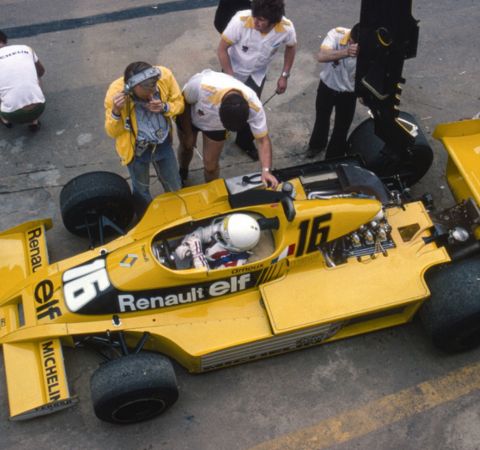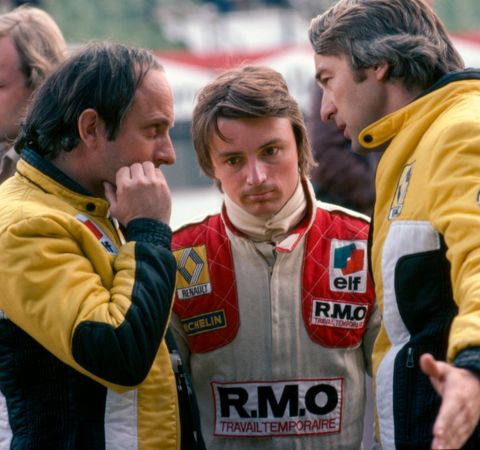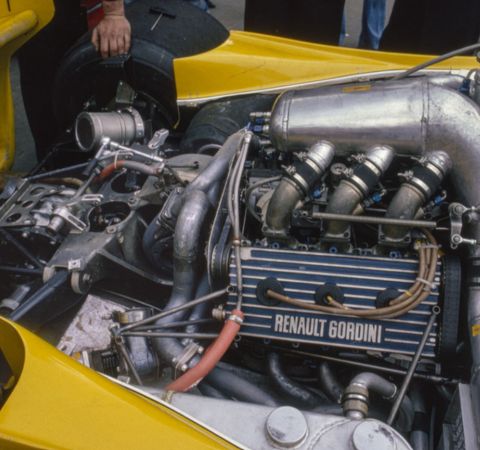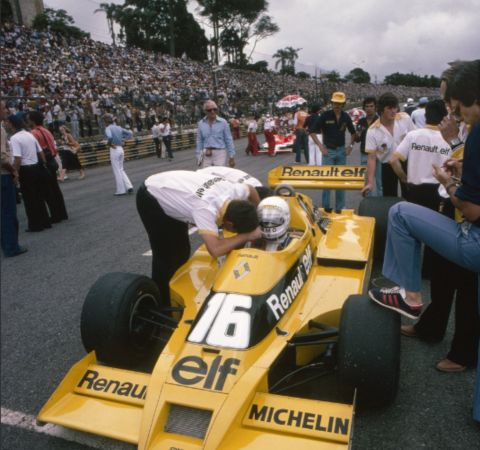René Arnoux’s Renault RS10
A symbol of technology and daring, the Renault RS10 is one of the rare vehicles to have marked the history of motor sport. Produced in just four units and driven by the Jabouille-Arnoux duo, this single-seater earned the team a place on the international stage.
In 2025, for the 49th edition of Rétromobile, the world's most exciting pop-up garage brought together the vehicle and its driver for an emotional reunion at the exhibit dedicated to French Formula 1.
Renault and Formula 1: a story of daring and passion

If René Arnoux's Renault RS10 is today considered a piece of global motorsport history, it is partly because it paved the way for the introduction of a revolutionary technology in Formula 1 at the time: the turbocharger.
The turbocharged ‘teapot’
Renault, already a competitor in several motor racing disciplines, saw Formula 1 as an international showcase and a means of promoting it brand and expertise. While the 1970s were dominated by naturally aspirated 3-litre engines, the French manufacturer made a bold decision to design a 1.5-litre turbocharged engine. The solution was approved by the FIA but shunned by other teams, who considered the technology too complex and unreliable. But it took more than that to scare the French team, which, under the leadership of Gérard Larousse, Bernard Dudot and François Castaing, began building a turbocharged single seater in 1976. The RS01 was unveiled a year later and made its debut at the 1977 Yellowstone Grand Prix.
However, despite the talent of its driver, Jean-Pierre Jabouille, the vehicle did not meet with the success that had been hoped for. This was due to its unreliable, not to say catastrophic, reliability, which earned the RS01 the nickname ‘Yellow Teapot’ (la théière jaune) in reference to the white smoke that regularly escaped from its engine when it broke down. In 1979, after two tumultuous seasons, the Renault RS01 was retired from championship competition and replaced by a car that would go on to make motor racing history: the Renault RS10.


RS10: pimping my ride
Whereas the RS01 fulfilled the role of a prototype, the RS10 embodied the French manufacturer’s motor racing prowess. The car used the same 1,492 cc supercharged V6 engine as its predecessor, but stood out through three additional features: a second turbocharger to reduce turbo lag, improved aerodynamics through ground effect conversion, and overall improved reliability. It was this addition that helped the French manufacturer find the recipe for success and change the face of Formula 1 forever. The RS10 officially made its debut on 29 April 1979 at the Spanish Grand Prix, at the same time as a newcomer to the Renault team: René Arnoux.
Alongside Jean-Pierre Jabouille, the young driver from the Isère department set out to offer France its debut win at Jarama. All in vain, alas, as the engines of both cars proved not to be up to the task. The curse would continue in the next two Grands Prix, in Belgium and Monaco, where the two drivers failed to finish in the points. But, to quote Napoleon Bonaparte “Impossible is a word to be found only in the dictionary of fools…” and the duo remained undeterred.
A debut win for the history books
On 1 July 1979, at the French Grand Prix, Jean-Pierre Jabouille took the chequered flag at the Dijon-Presnois racetrack. The result marked Renault's first ever victory and ushered in the era of turbocharged engines in Formula 1. While the victory was impressive, it was overshadowed by a fierce battle further back down the track between two other drivers, two nations and two temperaments: René Arnoux and Gilles Villeneuve. The pair went toe-to-toe in a duel of rare intensity. Their wheels touched and their racing lines cut across one another. It was a breath-taking spectacle, and the clash would be remembered for its symbolism: one of absolute confidence in one's own abilities and those of one's vehicle, but also, and above all, confidence in those of one's opponent and friend. After an intense six-lap chase, Villeneuve took second place, with Arnoux completing the podium. Two Frenchmen on the podium was a first in the history of Formula 1.
And the rest, as they say, is history. While the RS10 and its drivers continued to perform well for the rest of the season, the car still struggled with reliability issues. It was replaced at the start of the following season by the Renault RE20, a car that completed the transition to turbocharged engines in motor racing. René Arnoux left the Renault team at the end of the 1982 season. In 1983, he joined Scuderia Ferrari, with whom he would win three Grand Prix and achieve nine podium finishes.


